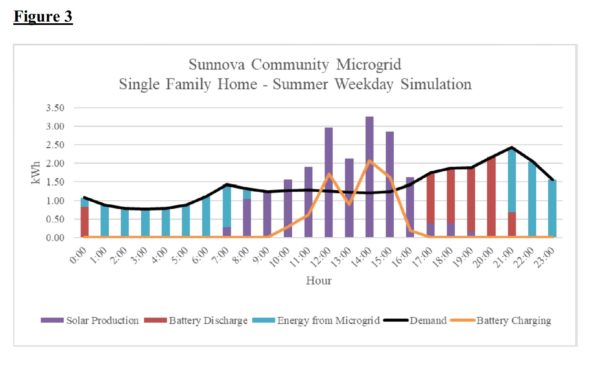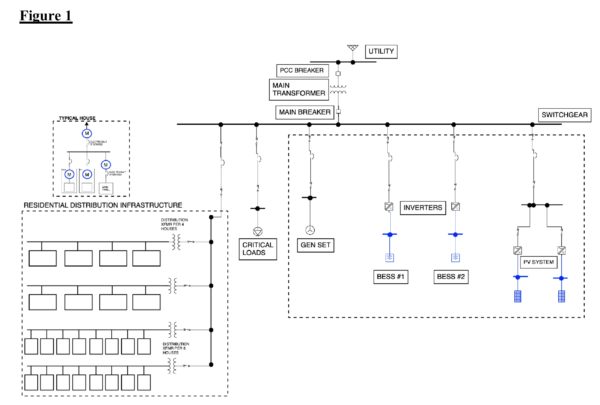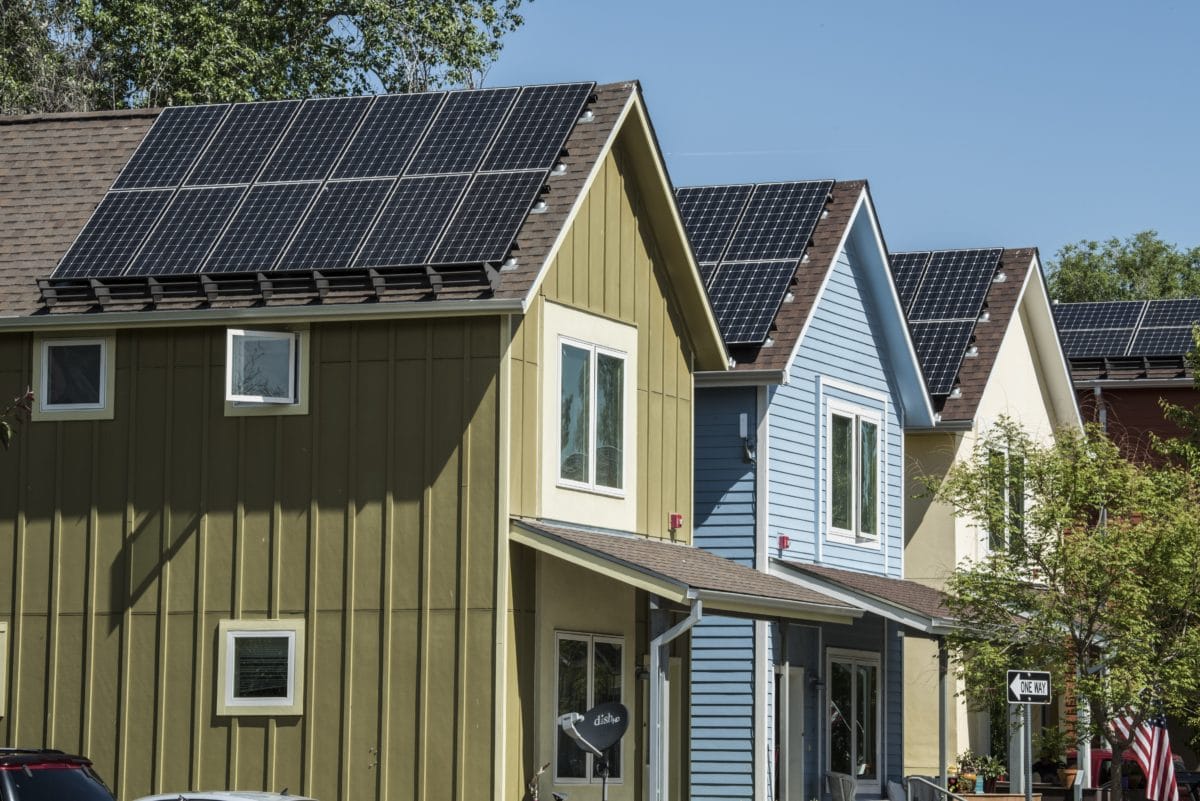In September, Sunnova submitted a proposal to the California Public Utilities Commission (CPUC), requesting that its newly formed subsidiary,- Sunnova Community Microgrids California (SCMC), fully own and operate microgrids of 500 to 2,000 new homes in the California market.
All three of California’s large, for-profit utilities have come out against the proposal. The Public Advocate’s Office of California has suggested that the proposal be dismissed, as the group would like to complete its own microgrid standards development.
The proposal is partially based upon the definition of an `electric microutility’, as per Section 2780 of California’s Public Utility Code. The code defines the microutiliy as:
Any electrical corporation that is regulated by the commission and organized for the purpose of providing sole-source renewable and stand-by generation, distribution, and sale of electricity exclusively to a customer base of fewer than 2,000 customers.
The original filing, Application…for a Certificate…To Construct and Operate Public Utility Microgrids and to Establish Rates for Service, is based on a simulation of a proposed 500 customer community by SCMC. The average home size of 2,300 sq feet would require a 7 kW solar system and a battery with two 5-10 kWh batteries. The community would build an additional 300 kW solar plant and have a local standalone battery of approximately 2 MWh. The plan includes a backup generator with a capacity of 2 MW.
SCMC estimates the installation would cost $8 to $10 million. Analysis suggests that the microgrid would experience less than 30 minutes of annual down time, and could supply power in isolation for over 300 hours if the broader grid went down.
Homes within the microgrid would get approximately 82% of their electricity from the microgrid, and the remaining 18% from the grid.

Source: Sunnova public filing
The image above shows a simulation of a single family home within the microgrid. During the peak evening period, the home draws from its own battery before shifting to the microgrid battery (around 21:00). SCMS says that they expect to make use of the “Sunnova Adaptive Home technology to manage load through behavioral demand response,” to mitigate grid demand during critical peak periods.
Because each project’s generation capacity is less than 50 MW, distribution equipment is under 50 kV, and costs are under $50 million, these microgrids are small enough to avoid the detailed scrutiny of utility scale projects.
The state’s for-profit utilities have advanced a handful of justifications for the proposal to be dismissed.
Among San Diego Gas & Electric Company’s objections is an argument that Sunnova’s microgrid cannot be defined as an electricity microutility, since a microutility must get its electricity from a single source, and Sunnova’s proposal indicates that 18% of their proposed microgrid’s electricity would be supplied by the broader grid. The utility company also advanced an argument stating that since the electric microutility account limit is 2,000 customers, Sunnova’s plan to create multiple unique companies containing 2,000 customers inappropriately attempts to circumvent those rules.

Source: Sunnova public filing
Pacific Gas & Electric took issue with Sunnova’s proposal as well, pointing out that an electric microutility is required to submit exact designs of their facility before being approved as a microutility. However, SCMC had already stated that they would provide designs upon creation of the individual communities.
The state’s Public Advocacy Office filed a motion to dismiss the application. Their first objection notes that if SCMC’s proposal were approved in its requested form, it would be operating under “drastically limited regulations,” and would require a number of rules to be waived. They also expressed concerns about how rate-making would be established.
The Public Advocacy Office also requested that the state finish designing its own microgrid rules before proceeding. Those rules have been under development since 2020.
Sunnova has since filed a response to the dismissal, and to many of the arguments put forward by the utilities.
A group of five, including the Center for Biological Diversity, filed a proposal in support of SCMC, noting that SCMC’s proposal gives California a chance to commercialize the microgrids within the state. They cite the 2030 goal of deploying 2.5 million more homes in the state.
This content is protected by copyright and may not be reused. If you want to cooperate with us and would like to reuse some of our content, please contact: editors@pv-magazine.com.









It’s great to see organizations like this beginning to pry some of the monopoly’s claws out of the consumer’s flesh.
Don’t bet on that as mostly changing one greedy corporation for another that you pay for everything and they make most of the money.
Their pay structure is a way street for now and not to the owner. Plus have to pay a lot for their system
It’ll be a bit before customers start making good money as more VPPs, microgrids, etc start paying, buying at market rates for on, off demand power but it is coming as with 100% RE, it needs to be done, real time pricing.
The California utilities pushed for de-regulation in the 1990s and get it only to have Enron manipulate the market. The utilities went bankrupt and were able to double the cost of electricity to its customers. TURN, a non-profit advocate for the poor, had the utilities push the higher electrical rates onto the non-poor. Based on usage, rates could go up to 48 cents per kilo watt hour on any electricity used over base line of 10 kilo watt hours per day. people who were paying $80.00 per month for electricity, at the pre-deregulation, were now paying $320.00 per month. Those that could afford to buy solar in California did so and the electrical rates have not come down but have been escalated even higher with the lower tiers and the utility is charging up to 49 cents per kilo watt hour during the 5 summertime peak hours from 4:00 PM to 9:00 PM. This is giving homeowners incentive to buy and use their own batteries charging them early in the day and using them instead of the costly peek time power. Utilities think they are an absolute necessity, like water utilities, but we can draw our power directly from the sun and store it for later use. When they threatened to add fees to solar customers, many will just take their systems off grid and form co-ops like this one. De-regulation, by the State, also allows customers to not connect to electrical utilities if they so choose.
Just “DUMP THE GRID”.. IF THE GRID OWNERS DO NOT “WORK” FOR YOU…
” IT’S EASY IF YOU TRY…”
For over 10 years now I have a Cabin in the Himalayas at 6,000 ft Elevation (in a developing nation.. not a developed nation like USA or California) with NO ELECTRIC OR WATER CONNECTION.. I have..
• PV Panels & Batteries for Electricity
• Solar Hot Air Heating/Rock Storage
• Solar Hot Water
• 125,000 Litre Rainwater Harvesting Tank (Tiled like a Swimming Pool)
• Recycling of Water in Garden, with Passive Septic Treatment Tanks..
• ZERO DISCHARGE OF WASTE WATER..
I NEVER HAVE A “LOSS OF POWER” OR ANY “WATER SHUTOFF” …
You guys in California… GROW UP .. STOP WHINING .. AND BE PROUD & INDEPENDENT CALIFORNIANS… AGAIN … DO YOU THINK YOU CAN DO THAT…???
START WITH … “DUMP THE GRID” … IF UTILITY OWNERS DONOT WORK WITH YOU… AND MOVE ON… TO WATER SELF-SUFFICIENCY /RECYCLING ETC..
REMIND THEM (& The PUC) THAT EVERY KWhr of DIRTY GRID ELECTRICITY (Fossil, Nuclear Plants) CREATES AN UNPAID GLOBAL SOCIETAL COST OF $0.31/KWhr ($9Million Premature Deaths Annually and 275MillionDALY of Suffering .. at $1 Million/Victim & $100,000/DALY of Suffering respectively … $36.5 Trillion/yr … on the 120,000TWhrs/yr of Energy Use around the world) ).
IF THEY DONOT COOPERATE DEMAND THE ABOVE PMP LEVY ON DIRTY ELECTRICITY.. AS PER THE 1992 RIO AGREEMENT OF THE PMP PRINCIPLE.. AGREED TO BY THE USA TOO.. AND CREDIT IT DIRECTLY TO SOLAR/NON-POLLUTING ENERGY PRODUCERS … and WATCH CALUFORNIA AND REST OF WORLD … DUMP THE GRID… FAST.. VERY FAST.. !!!
[ Solar Panels Annually produce 1.2+KWhrs/W and Cost about $0.35/W.. or about $1-1.20/W for the PV System…
At the Current Retail Elec. Rate of 0.10/KWhr (including ALL TAXES & CHARGES) + $0.31/KWhr (PMP Levy).. you get a ROI of 2.5-3 years… ]..
BEST OF LUCK…!!!!
Wow Ajay, very interesting and cool. Wish I could visit.
NO BODY EVEN THE SUPREME COURT CAN FORCE ANYONE TO BUY ELECTRICITY OR FOR THAT MATTER ANYTHING FROM ANYONE… IS THE USA A FREE COUNTRY OR NOT…
As long as you do not affect your neighbor or others… (like sewage/septic) you have a God-Given RIGHT to generate your own Pollution Free Electricity… your statement (below) appears to, erroneously” give De-regulation those Powers… that RIGHT BELONGS TO YOU ONLY AS LONG AS YOU DONOT CROSS YOUR PRIVATE PROPERTY BOUNDARY..
” De-regulation, by the State, also allows customers to not connect to electrical utilities if they so choose.
America used to be free. But those are all-in on petroleum will not go down without a fight. they already have legislation that puts them in the drivers’ seat. everything that tries to get going, every innovation, is dead on arrival because petroleum rules. coal didn’t have a chance, but coal is nothing compared to petroleum.
How do you ever fix a broken, corrupt system where entrenched, big money interests finance politician’s campaigns? And when a few honest politicians put forward bills to overhaul campaign finance, they get shot down. And the vast majority of voters are too ignorant and too lazy to look deeply enough into politician’s actions and voting records to ever boot the thieves out.
I hope to build a community but in far smaller, tiny homes that will supply their own power in a microgrid or on their own.
And looking for property to start building solar homes, carports, sheds to sell to anyone is going tp put a serious hurt in utilities as home, building, business and EVs with V2G take over the majority of storage and on demand generation.
So utilities better learn to live with them soon before it gets overrun by them and go bankrupt from massive debts on stranded assets.
And not just those but whole communities, cities will leave the big utilities causing their demise to be faster like 75% of IOUs will be bankrupt in 10 yrs, if not more of them.
And big solar, wind, etc better get ready for their PPA contracts to get canceled with them as they go bankrupt.
The homes in the proposal are obscenely large!